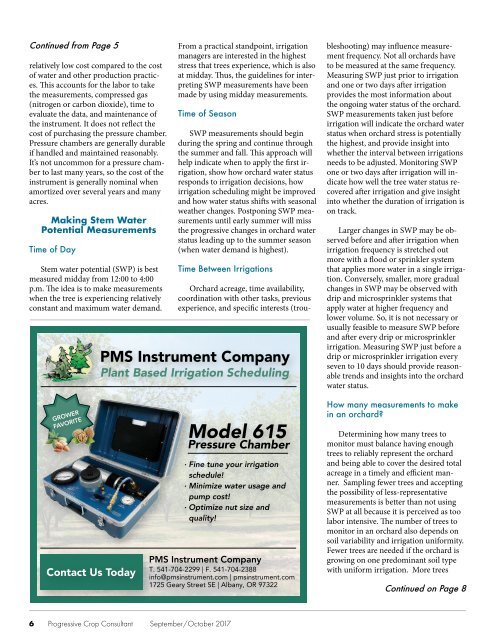September/October 2017
Create successful ePaper yourself
Turn your PDF publications into a flip-book with our unique Google optimized e-Paper software.
Continued from Page 5<br />
relatively low cost compared to the cost<br />
of water and other production practices.<br />
This accounts for the labor to take<br />
the measurements, compressed gas<br />
(nitrogen or carbon dioxide), time to<br />
evaluate the data, and maintenance of<br />
the instrument. It does not reflect the<br />
cost of purchasing the pressure chamber.<br />
Pressure chambers are generally durable<br />
if handled and maintained reasonably.<br />
It’s not uncommon for a pressure chamber<br />
to last many years, so the cost of the<br />
instrument is generally nominal when<br />
amortized over several years and many<br />
acres.<br />
Making Stem Water<br />
Potential Measurements<br />
Time of Day<br />
Stem water potential (SWP) is best<br />
measured midday from 12:00 to 4:00<br />
p.m. The idea is to make measurements<br />
when the tree is experiencing relatively<br />
constant and maximum water demand.<br />
From a practical standpoint, irrigation<br />
managers are interested in the highest<br />
stress that trees experience, which is also<br />
at midday. Thus, the guidelines for interpreting<br />
SWP measurements have been<br />
made by using midday measurements.<br />
Time of Season<br />
SWP measurements should begin<br />
during the spring and continue through<br />
the summer and fall. This approach will<br />
help indicate when to apply the first irrigation,<br />
show how orchard water status<br />
responds to irrigation decisions, how<br />
irrigation scheduling might be improved<br />
and how water status shifts with seasonal<br />
weather changes. Postponing SWP measurements<br />
until early summer will miss<br />
the progressive changes in orchard water<br />
status leading up to the summer season<br />
(when water demand is highest).<br />
Time Between Irrigations<br />
PMS Instrument Company<br />
Plant Based Irrigation Scheduling<br />
Orchard acreage, time availability,<br />
coordination with other tasks, previous<br />
experience, and specific interests (troubleshooting)<br />
may influence measurement<br />
frequency. Not all orchards have<br />
to be measured at the same frequency.<br />
Measuring SWP just prior to irrigation<br />
and one or two days after irrigation<br />
provides the most information about<br />
the ongoing water status of the orchard.<br />
SWP measurements taken just before<br />
irrigation will indicate the orchard water<br />
status when orchard stress is potentially<br />
the highest, and provide insight into<br />
whether the interval between irrigations<br />
needs to be adjusted. Monitoring SWP<br />
one or two days after irrigation will indicate<br />
how well the tree water status recovered<br />
after irrigation and give insight<br />
into whether the duration of irrigation is<br />
on track.<br />
Larger changes in SWP may be observed<br />
before and after irrigation when<br />
irrigation frequency is stretched out<br />
more with a flood or sprinkler system<br />
that applies more water in a single irrigation.<br />
Conversely, smaller, more gradual<br />
changes in SWP may be observed with<br />
drip and microsprinkler systems that<br />
apply water at higher frequency and<br />
lower volume. So, it is not necessary or<br />
usually feasible to measure SWP before<br />
and after every drip or microsprinkler<br />
irrigation. Measuring SWP just before a<br />
drip or microsprinkler irrigation every<br />
seven to 10 days should provide reasonable<br />
trends and insights into the orchard<br />
water status.<br />
GROWER<br />
FAVORITE<br />
Contact Us Today<br />
Model 615<br />
Pressure Chamber<br />
· Fine tune your irrigation<br />
schedule!<br />
· Minimize water usage and<br />
pump cost!<br />
· Optimize nut size and<br />
quality!<br />
PMS Instrument Company<br />
T. 541-704-2299 | F. 541-704-2388<br />
info@pmsinstrument.com | pmsinstrument.com<br />
1725 Geary Street SE | Albany, OR 97322<br />
How many measurements to make<br />
in an orchard?<br />
Determining how many trees to<br />
monitor must balance having enough<br />
trees to reliably represent the orchard<br />
and being able to cover the desired total<br />
acreage in a timely and efficient manner.<br />
Sampling fewer trees and accepting<br />
the possibility of less-representative<br />
measurements is better than not using<br />
SWP at all because it is perceived as too<br />
labor intensive. The number of trees to<br />
monitor in an orchard also depends on<br />
soil variability and irrigation uniformity.<br />
Fewer trees are needed if the orchard is<br />
growing on one predominant soil type<br />
with uniform irrigation. More trees<br />
Continued on Page 8<br />
6 Progressive Crop Consultant <strong>September</strong>/<strong>October</strong> <strong>2017</strong>


















